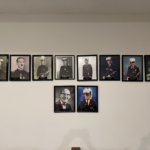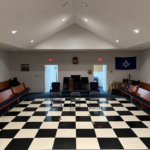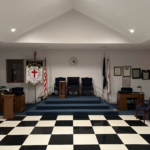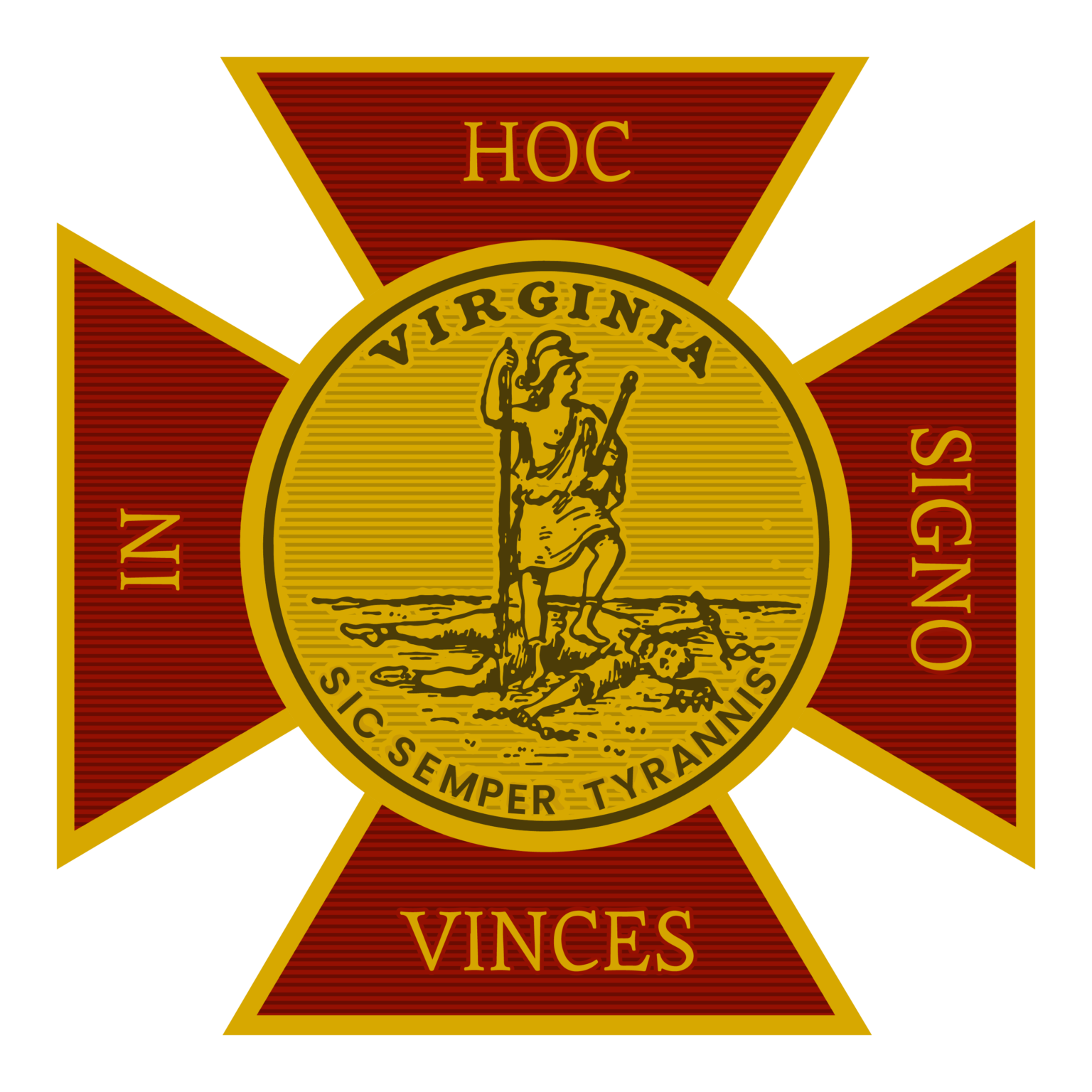Chartered November 13, 1889
Information for this was obtained from the minute books of Bayard Commandery and the 1990 Hundred Year Anniversary book that was prepared by Commander W.W. Longworth.
Bayard Commandery was first conceived on February 2, 1889, in the office of Winch and McCahan, on Saturday evening, that office being located in the old Masonic Lodge building at number 6 Campbell Ave, S.W. Winch and McCahan were realtors and land developers in Roanoke at the time.
Sir Knight William H. Pleasants, who later became Grand Master of Masons in Virginia, was the Master of Ceremonies. The purpose of the meeting was to settle on a name for the Commandery and to name the first officers.
The name “BAYARD” was suggested because Seigneur Pierre Terrail DeBayard was a French military hero and also a Knight Templar. DeBayard was born in 1473 and died in 1524. All present liked the name, and it was so ordered.
The following officers were named:
W.F. Winch – Commander
Wm. H. Pleasants – Generalissimo
H.N. Claxton – Captain General
H. Groves – Senior Warden
J.R. Hanthorne – Junior Warden
John Chaimers – Prelate
R.S. Roberts – Recorder
A. McD. Smith – Standard Bearer
John G. Osborne – Sword Bearer
F.L. Wood – Warder
W.H. Walthall – Tiler
It was not until October 16, 1891, that William F. Winch is recorded as the first Treasurer. The above officers were agreed upon and later appointed by the Grand Commander.
Sir Knight Winch made a motion that each of the Charter members pay a fee of $5.00, the same to apply on dues. After the organization of said Commandery, the motion was carried out and thus ended the first recorded meeting of Bayard Commandery.
February 16, 1889. It was ordered that all the members procure uniforms so the Commandery could properly confer the orders. The cost of $80.00 would cover a complete uniform. Much has changed since then.
March 22, 1889. Recorded the first death in Bayard Commandery, that of Sir Knight D.F. Houston. A page was reserved in the Minute Book as a memorial to him. The motion of Sir Knight Claxton that the Commandery meet on the second Saturday of each month was carried. Receipts of this meeting were $85.00. Eleven candidates were also elected to receive the orders.
September 20, 1889. We learned that the minutes of the last Stated and Called Meetings were not read because they had not been properly written. (All minutes were hand written and easily read). We also learned that the rent to Lakeland Lodge would be $42.00 for each quarter. The notification to the members would be by a penny postcard (Today’s postcard stamp is $0.35).
December 20, 1889 (Commandery Constituted). The minutes show the first recorded meeting of Bayard Commandery No.15. The meeting was opened by Sir Knight Winch and Right Excellent J.S. Beck. Right Excellent R.T. Craighill constituted the Commandery as “Bayard No. 15”, installed the following officers, and wished them well for the coming year:
W.F. Winch – Commander
Wm. F. Pleasants – Generalissimo
H.N. Claxton – Captain General
H. Groves – Senior Warden
J.R. Hanthorne – Junior Warden
John Chalmers – Prelate
A.L. Treamin – Treasurer
R.S. Roberts – Recorder
A. McD. Smith – Standard Bearer
John G. Osborne – Sword Bearer
F.L. Wood – Warder
W.H. Walthall – Tiler
The bill for the refreshments for 48 members present at this meeting was $11.90 – a lot of money at that time.
The First Knight Templar Funeral Service Recorded. On October 10, 1889, at 8:00 A.M., the Commandery met in the Asylum in full dress uniform by order of the Commander to pay the last tribute of respect to their late Frater Sir Knight and first Standard Bearer A. McD. Smith.
In a body they went to the home of the deceased and marched in procession carrying the body to the Episcopal Church where services were held; then, to the cemetery where the body was interred in accordance with the Knight Templar services, after which they marched back to the Asylum and were dismissed.
Things are going up. On March 20, 1891, the By-Laws were changed from $20.00 for the Orders of Knighthood to $50.00.
April 15, 1897. The first typed and signed copy of an audit report. By this time Bayard Commandery was in charge of the Temple Corporation of Lakeland Lodge No. 190, where you read in Lakeland minutes paying rent to Bayard No. 15:
To the Officers and Members of Bayard Commandery No 15 K. T. Roanoke, VA
Below please find statement of Receipts and Disbursements of our Commandery for the year commencing June 1, 1896 and ending June 1, 1897
Balance of Cash on hand June 1, 1896 $ 77.00
Collection of Fees $ 10.00
Collection of Dues 322.39
Collection of Rents 481.00
Total collections for the year 813.39
Total collections and cash on hand for the year $ 890.39
Disbursements
Salary of Recorder $ 75.00
Postage, Expressage and Telegrams 15.41
Salary of Sentinel 60.00
Electric Light 126.00
Gas 17.73
Repairing Curtains 1.00
Rent of Hall 300.00
Kitchen ware 1.23
Stationery 16.75
Grand Lodge Tax 79.00
Grand Lodge Repetitive expenses 6.00
Treasurer’s salary 6.00
Total disbursements for the year 704.12
Balance of Cash in Treasurer’s hands June 1st 1897 $ 186.27
From February 2, 1889, to April 6, 1890 (Meetings Canceled). Six meetings were canceled during these years because of lack of a quorum.
Past Grand Commanders of Bayard # 15:
WM. C. Stevenson 1908-1909
Robert Frances Taylor 1914-1945
William M. Oakey 1920-21
Frank G. Payne 1934-35
Fritz Allen Brown 1954-55
Robert Lee Price, Jr. 2002-2003
Why Can’t Commanderies Do This Today? In the early years, Bayard Commandery would visit with DeMolay Commandery No. 4 in Lynchburg, Virginia, and Dove Commandery No. 7 in Danville, Virginia, on weekends. They would travel by train, leaving Roanoke on Friday, and returning to Roanoke on Sunday evening. While at either place the Sir Knights would witness the Order of the Temple conferred while their ladies were entertained by the wives of the officers of the other Commandery, after which they would be entertained by a gala dinner in full dress uniform, ladies in long gowns. On Saturday, and after church on Sunday, they would be taken on a tour of some interesting places in the city and return home on Sunday night.
Knights Templar Gather (Annual Inspection of Lynchburg, Danville and Roanoke Commanderies). Roanokers yesterday were treated to a somewhat unusual scene when three splendidly uniformed commanderies of Knights Templar marched through their principal streets. The big conclave of Knights Templar of yesterday, a joint inspection of three commanderies, Roanoke, Lynchburg and Danville, is held annually, and the report on the same forwarded to the Grand Commandery at Richmond, whose session is held in November. The visiting commanderies were DeMolay Commandery, of Lynchburg, and Dove Commandery, of Danville. At 2:30 O’clock in the afternoon a committee consisting of Mr. E.B. Jacobs, Dr. F. Wood and Jno. M. Snyder of Bayard Commandery, of Roanoke, met the visiting Commanderies at the train which had arrived from Lynchburg. Before the visitors had left the platform Bayard Commandery, in force, headed by Eminent Commander Taylor, appeared and departing from the station, a march was made through the principal streets of the city. Admiring crowds thronged the thoroughfares and many pleasing comments were uttered as the attractively uniformed Knights Templar swung by. After a parade of the leading streets, the route led back to the Hotel Roanoke grounds where a general inspection of the several commanderies took place. The inspectors who reviewed the evolutions of the men were E.D. Hotchkiss, P.C., of Richmond No.13 for DeMolay Commandery No. 4 of Lynchburg; I.H. Adams, Jr., P.C. of DeMolay Commandery No. 4 for Dove Commandery No. 7 of Danville; J.B. Blank, P.G.C. of the State Commandery, inspected Bayard Commandery No. 15 of Roanoke.
The combined commanderies made a splendid showing and went through the various evolutions and drills with much grace and smoothness. All were complimented on the conclusion of the drill, which lasted over half an hour by the inspectors.
The various officers’ presents were as follows: James G. Blank, P.G.C.; E.H. Miller, P.G.C.; Dr. J. W. Bryant, G.J.W.; W.C. Stephenson, Grand Warder.
The past commanders present were as follows: Rev. J. Cleveland Hall, P.C. of Dove Commandery, Danville; E.G. Moseley, H.M. Martin and S.W. Martin, of Dove Commandery; W.O. Johnson, I.H. Adams, Jr., W.M. Oakey, J.R. Kyle, P.C.’s of DeMolay No. 4 of Lynchburg; W.F. Winch, Joh M. Snyder, A.B. Hammond, Dr. F.L. Wood and E.B. Jacobs, P.C.’s of Bayard Commandery No. 15, of Roanoke.
The Commanderies were in charge during the day of the following commanders, J.B. Oglesby, Eminent Commander of DeMolay No. 4, of Lynchburg; A.W. Taylor, Eminent Commander of Dove No. 7, of Danville, and Frank Taylor, Eminent Commander, of Bayard No. 15, of Roanoke.
Following the inspection, the visiting commanderies, together with the local knights who had gone in the meantime to the lodge rooms, took trolley cars for a ride around the city. During the course of the trip the Elks’ beautiful home on Jefferson Street was inspected, and courteous hosts provided refreshment for the Templars. Supper at the Ponce De Leon Hotel followed, the guests all showing excellent appetites for the evening meal.
At 8:30 o’clock all gathered at the lodge rooms, corner of Campbell and Jefferson, where a most enjoyable “smoker” was participated in by all. Here, too, the social side of the conclave came uppermost, and songs and speeches of a jovial order prevailed. The Roanoke Machine Works Band, which had rendered such pleasing music on the march through the city’s streets, were present at the smoker and gave many fine selections. A happy time was spent by all until about 11 o’clock, when adjournment was taken to the Hotel Roanoke, where a banquet was served by Bayard Commandery to the visiting Brethren.
At the Hotel Roanoke the banquet proved a most appetizing and delightful one. Speeches were made by H.M. Boghen, Grand Commander; Sir Knight King, of Lynchburg; Sir Knight Brabe, of Danville; Sir Knight Jennings and Sir Knight Moseley, of Danville.
Captain R.F. Taylor acted as toastmaster during the festivities. The speeches were all short, owing to the lateness of the hour, and the fact that many of the visiting Brethren wished to catch departing trains.
All told there were about 175 men in line during the parade from the various commanderies.
These affairs by the three Commandries continued until the very early forties when, perhaps, the war years had something to do with these great events being concluded. What a shame!
October 19,1897. First Recorded Request for Demit by Sir Knight John G. Osborne.
Corner Stone Laid. On July 4, 1901, Bayard Commandery No. 15 assisted in the laying of the cornerstone of the Administrative Building of the Baptist Orphanage in Salem, Virginia.
Room Available at the Old Roanoke Hospital. In the early years, and up until the forties, Bayard Commandery No. 15, Murray Royal Arch Chapter No. 22 and Lakeland Lodge No. 190 kept a room at the hospital on a daily basis for those members and their families who could not afford the fare.
In conclusion
Bayard Commandery, at one time, reached a membership of about 800 strong. In 1990 the membership had declined to about 300 and today the membership is approximately 90.
In 1990 Commander W.W. Longworth stated “It is the belief of this Commander that if York Rite Masonry was promoted in the public eye, and to every Master Mason, the Christian Order of Freemasonry would rise and out rank any other order. This could be done by re-enacting the joint inspections of yesteryear and the special excursions to other Commanderies, accompanied by our ladies, with parades through towns and gala dinners and tours of special places in full uniform. Something like this would surely catch the eye of the public and make someone interested in what we are doing.
Our contributions to the Holy Land Tour and the Knights Templar Eye Foundation should be reported in the newspaper, instead to only our members. We cannot expect to grow if no one knows we exist.”
Things have not changed much since 1889 except our name is not well known in the community and membership has declined except the minutes are now typed rather than handwritten. However, we believe what Commander Longworth stated in 1990 is still true today.








